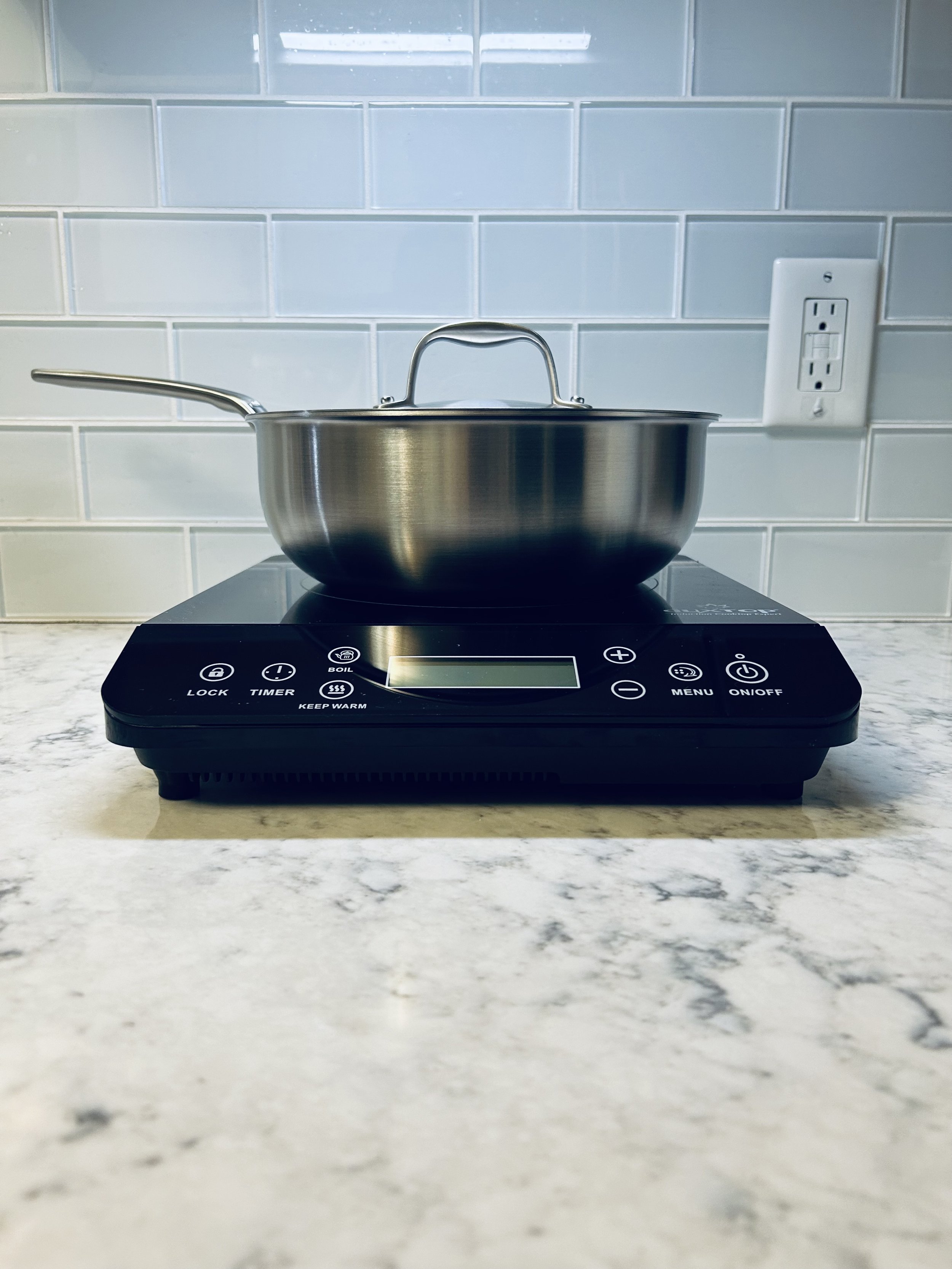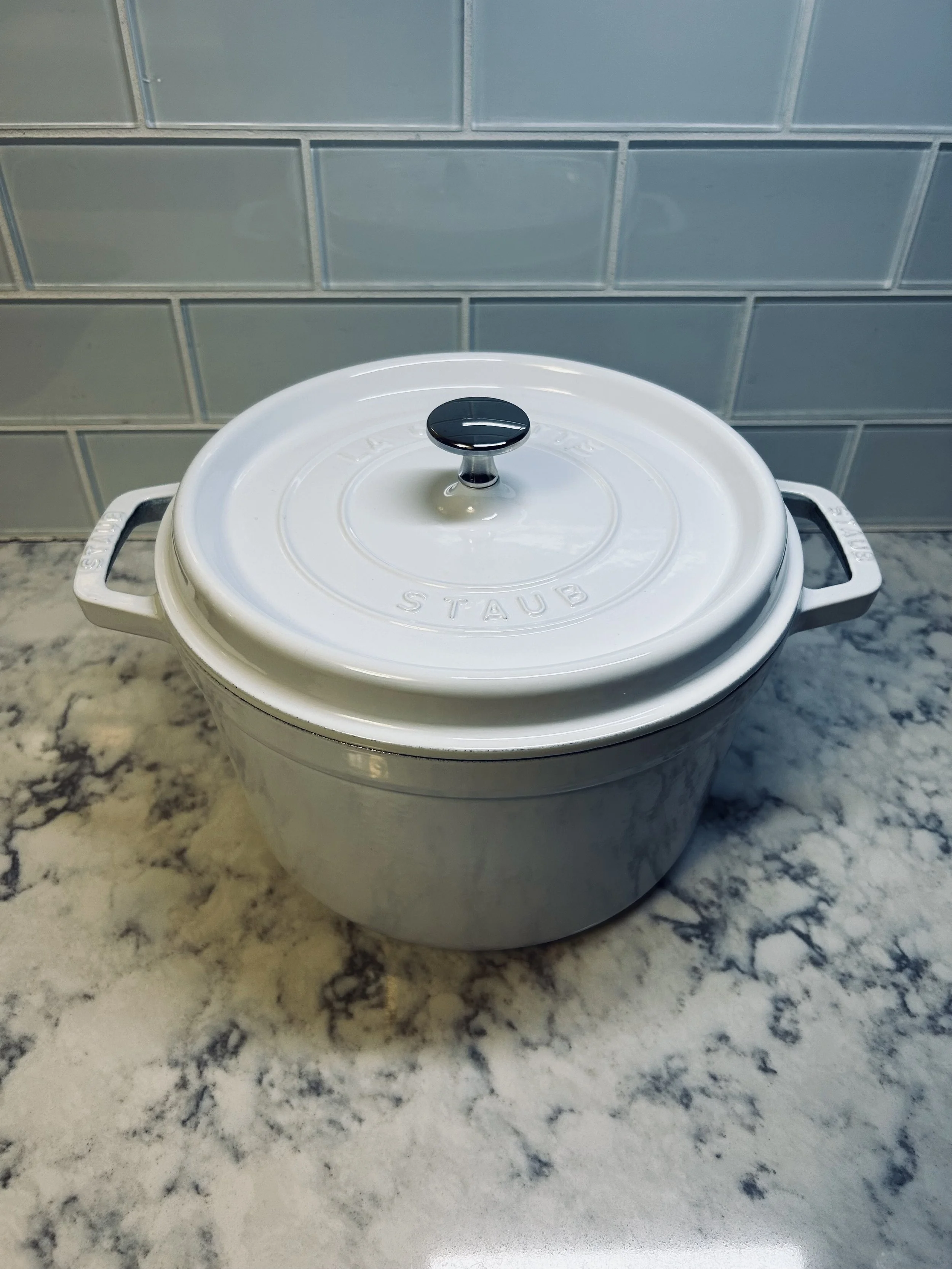
Cookware 101
In my opinion, every kitchen should have a pair of frying pans (10”, 12”), a 3-4 QT saucepan, a 3-5 QT sauté pan (or saucier), and a 6-8 QT stock pot. I also strongly recommend having a 5-8 QT cast iron Dutch oven and a 10”-12” cast iron skillet. These seven main pieces of cookware will turn you into a pro home cook. Choose the size(s) that suit your needs.
Stove Type
When selecting your cookware the very first thing you need to know is your stove type and which materials will function properly on your range. Do you have gas, an electric, or an induction stove top or cooking surface? The type of cooking surface you have will factor heavily into your decision of what type of cookware to purchase. Gas stoves are the work horses in the industry and across many homes (I wish I had a gas range). Gas stove tops do not discriminate against cookware— anything and everything works.
What is induction and how does it work? Induction utilizes electromagnetic energy to directly heat cookware rather than the the actual cooking surface. The cooking surface itself, does not heat up, but the cookware does. Pretty cool stuff. Induction can make choosing cookware a bit more difficult though since not every core type is induction-compatible.
What is the difference between an induction and an electric cooking surface? They look exactly the same. It simply boils down to how they transfer heat. Electric stove tops radiate heat from coils underneath the cooking surface; transferring that heat to the cookware above. Induction, as just mentioned, heats cookware directly. Electric has to essentially heat up twice. First the element and then the cookware. Induction only has to heat the cookware meaning induction is much, much faster.
I have an electric cooking surface in my home and while it’s not ideal, it gets the job done. The deficiencies of electric are partially offset from investing in premium-quality cookware. I also have a plug-in induction burner as well that I use when I need faster heating times, better retention and reliability, and even distribution.
Core Type
The core refers to the material type that is the central heating element and provides heat distribution and determines durability— copper, stainless steel, and aluminum are the most common types of cores found in most cookware. Copper is the best for heat conductivity, retention, and even distribution of heat. Copper is expensive though and prone to discoloration. Stainless steel is very durable, non-reactive to food (i.e. acidic foods), and has solid heat retention. However, inexpensive stainless steel may have issues retaining and distributing heat evenly. Non high-quality stainless steel may not work on every stove type (induction) either because of the core type. Aluminum is affordable and lightweight, but is not made for high-heat exposure and may warp.
Cast iron and carbon steel cores are both derived from carbon, but the carbon content is significantly different. Cast iron is highly-durable, has excellent heat retention, and is great for high-heat cooking. It is, however, heavy and can be prone to rusting. Carbon steel possesses similar characteristics to cast iron, but is much lighter and heats up and cools down more quickly. Both cooking surfaces will become completely non-stick over time with proper seasoning, regular use, and maintenance.
My personal preference is full-clad stainless steel with a copper core. You get the desirable characteristics of stainless steel, the heating properties of copper, and they will work on every stove type. Full-clad simply means that the core extends to the outermost edges of the pot or pan. I will always recommend having a cast iron and/or carbon steel cookware option in your kitchen too.
Surface Type
The surface type of your cookware will ultimately come down to your preference and what you are the most comfortable with. My personal preference is stainless steel. Stainless steel does require a little more experience to work with comfortably and can be more difficult to clean. Cast iron and carbon steel can also be semi-difficult for newer home cooks since they need to be seasoned first and maintained correctly to prevent rusting. Enameled cast iron is wonderful and easier to maintain, but can be very expensive.
If you are new to cooking I would recommend non-stick cooking surfaces. In fact, every kitchen should have a couple non-stick options. You won’t have to worry about your food sticking or burning as quickly and they are much easier to clean. Most non-stick cookware is not oven safe though. Make sure to avoid non-stick cookware that may contain PFAS, PFOA, and PTFE. These chemicals used in non-stick cooking surfaces have potential health concerns. Ceramic cookware seems to be a very popular non-stick option these days.
Oven Use
Will you be preparing dishes that require braising or general oven use? This will help you determine what material some of your cookware may need to be and what types of handles you can and cannot have. In general for oven use I would strongly suggest having both an enameled Dutch oven and a cast iron skillet. Many stainless steel options are oven safe as well, but not all. When purchasing cookware check the oven safe temperatures. I prefer to look for cookware (more specifically non-stick cookware) that is oven safe up to 500 degrees F.
Storage
One of the biggest challenges as you accumulate cookware is— storage. Pots and pans take a lot of space, but you still want them to be easily accessible. It never hurts to weigh your storage capacity into your decision when making an investment on cookware. What type of storage do you have (cabinets, closet, or hanging)? Do you want cookware that’s designed to stack? Maybe you should just hire Marie Kondo for this one.
Alex Cooks Food Selections
Made In 5 Ply ProCoat Non-Stick Frying Pan (8”)
Made In 5 Ply ProCoat Non-Stick Frying Pan (10”)
Made In 5 Ply Stainless Clad Frying Pan (12”)
Made In 5 Ply Stainless Clad Butter Warmer (3/4 QT)
Made In 5 Ply Stainless Clad Saucier (3 QT)
Made In 5 Ply Stainless Clad Sauté Pan (3.5 QT)
Made In 5 Ply Stainless Clad Saucepan (4 QT)
Made In 5 Ply Stainless Clad Stock Pot (8 QT Pasta Bundle)
As an Amazon Associate, I earn from qualifying purchases.
